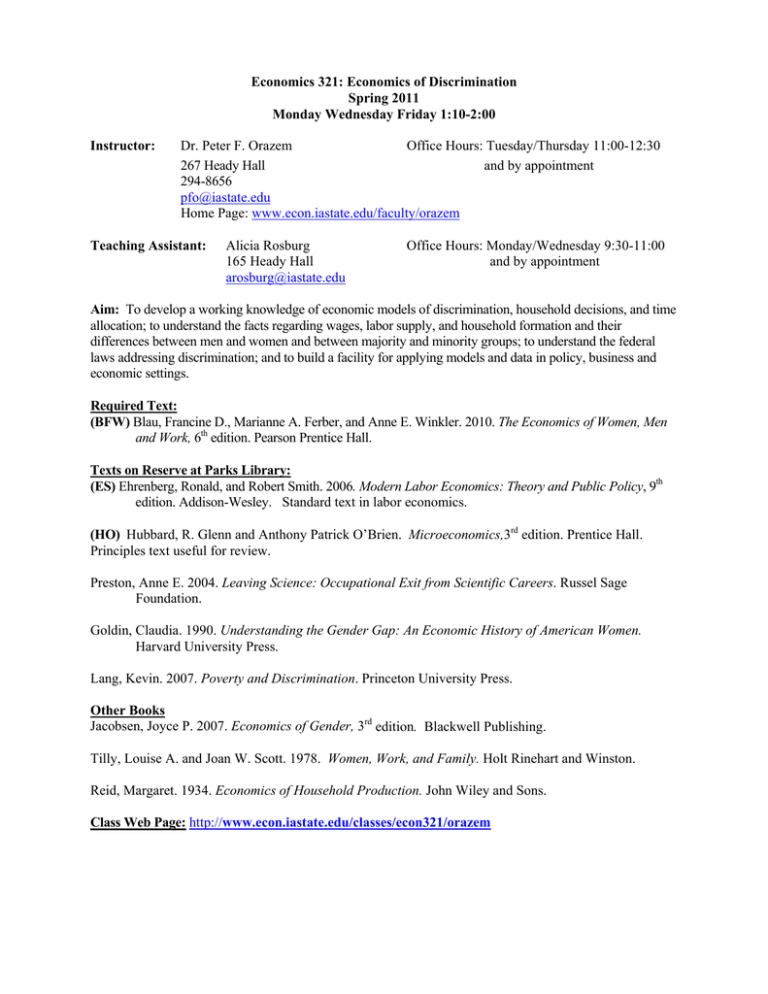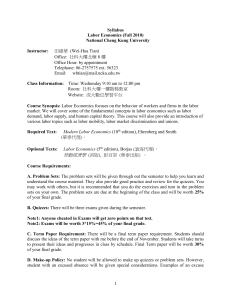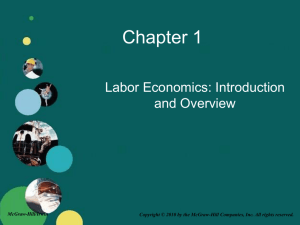
Economics 321: Economics of Discrimination
Spring 2011
Monday Wednesday Friday 1:10-2:00
Instructor:
Dr. Peter F. Orazem
Office Hours: Tuesday/Thursday 11:00-12:30
267 Heady Hall
and by appointment
294-8656
pfo@iastate.edu
Home Page: www.econ.iastate.edu/faculty/orazem
Teaching Assistant:
Alicia Rosburg
165 Heady Hall
arosburg@iastate.edu
Office Hours: Monday/Wednesday 9:30-11:00
and by appointment
Aim: To develop a working knowledge of economic models of discrimination, household decisions, and time
allocation; to understand the facts regarding wages, labor supply, and household formation and their
differences between men and women and between majority and minority groups; to understand the federal
laws addressing discrimination; and to build a facility for applying models and data in policy, business and
economic settings.
Required Text:
(BFW) Blau, Francine D., Marianne A. Ferber, and Anne E. Winkler. 2010. The Economics of Women, Men
and Work, 6th edition. Pearson Prentice Hall.
Texts on Reserve at Parks Library:
(ES) Ehrenberg, Ronald, and Robert Smith. 2006. Modern Labor Economics: Theory and Public Policy, 9th
edition. Addison-Wesley. Standard text in labor economics.
(HO) Hubbard, R. Glenn and Anthony Patrick O’Brien. Microeconomics,3rd edition. Prentice Hall.
Principles text useful for review.
Preston, Anne E. 2004. Leaving Science: Occupational Exit from Scientific Careers. Russel Sage
Foundation.
Goldin, Claudia. 1990. Understanding the Gender Gap: An Economic History of American Women.
Harvard University Press.
Lang, Kevin. 2007. Poverty and Discrimination. Princeton University Press.
Other Books
Jacobsen, Joyce P. 2007. Economics of Gender, 3rd edition. Blackwell Publishing.
Tilly, Louise A. and Joan W. Scott. 1978. Women, Work, and Family. Holt Rinehart and Winston.
Reid, Margaret. 1934. Economics of Household Production. John Wiley and Sons.
Class Web Page: http://www.econ.iastate.edu/classes/econ321/orazem
2
Course Outline
Note: Required readings denoted by an asterisk (*) Background readings are denoted by (#) if you need a
refresher
I. Introduction to labor markets and discrimination
*BFW, Chapters 1 and 7 (pages 193-194)
#For review, see HO chapter 16
II. Working men and women in historical and international context and the economics of home
production
*BFW, Chapters 2 and 12
#ES, Chapter 7
#HO, Appendix to Chapter 10 (pages 355-364)
Tilly, Louise A. and Joan W. Scott. 1978. Women, Work, and Family
Mammen, Kristin and Christina Paxson. 2000. “Women's Work and Economic Development.” Journal of
Economic Perspectives 14 (Fall): 141-164.
Cowan, Ruth Schwartz. 1976. “The "Industrial Revolution" in the Home: Household Technology and
Social Change in the 20th Century.” Technology and Culture 17 (January): 1-23.
Costa, Dora L. 2000. “From Mill Town to Board Room: The Rise of Women's Paid Labor.” Journal of
Economic Perspectives 14 (Fall): 101-122.
Goldin Chapters 2, 5
III. Theory and evidence of marriage and family formation
#BFW Chapters 3, 9:273-293
Costa, Dora. 2000. “Power Couples: Changes in the Locational Choice of the College Educated, 19401990.” Quarterly Journal of Economics 115: 1287-1315.
Stevenson, Betsey and Justin Wolfers. 2007. “Marriage and Divorce: Changes and their Driving Forces.”
The Journal of Economic Perspectives 21(2): 27-52.
Fryer, Roland G. Jr. 2007. “Guess Who’s Been Coming to Dinner? Trends in Interracial Marriage over
the 20th Century.” The Journal of Economic Perspectives 21(2): 71-90.
Black, Dan A., Seth G. Sanders and Lowell J. Taylor. 2007. “The Economics of Lesbian and Gay
Families.” The Journal of Economic Perspectives 21(2): 53-70.
Mechoulan, Stèphane. 2011. “The External Effects of Black Male Incarceration on Black Females.”
Journal of Labor Economics 29(1):1-36.
Goldin, Chapter 6
Lang, Chapter 6
3
IV. Intergenerational transmission of wealth and poverty
Fryer, Roland G. Jr. and Steven D. Levitt. 2004. “The Causes and Consequences of Distinctively Black
Names.” Quarterly Journal of Economics 119 (3): 767-805.
Cunha, Flavio, James J. Heckman, Lance Lochner and Dimitriy V. Masterov. 2006.
“Interpreting the evidence on life cycle skill formation.” In E. A. Hanushek and F. Welch, eds.
Handbook of the Economics of Education, Vol 1. Amsterdam: Elsevier B.V.
Lang, Chapters 11 and 12
V. Female labor supply at home and abroad
*BFW Chapters 4, 11
#ES Chapter 6
Bailey, Martha. 2006. “More Power to the Pill: The Impact of Contraceptive Freedom on Women’s
Life Cycle Labor Supply.” Quarterly Journal of Economics (Feb.) 121: 289-320.
Aguiar, Mark and Erik Hurst. 2007. “Measuring Trends in Leisure: The Allocation of Time over Five
Decades.” Quarterly Journal of Economics (Aug.) 122: 969-1006.
Anderson, Deborah J., Melissa Binder and Kate Krause. 2003. “The Motherhood Wage Penalty
Revisited: Experience, Heterogeneity, Work Effort, and Work Schedule Flexibility.” Industrial and
Labor Relations Review 56 (January): 273-294.
Folbre, Nancy and Julie A. Nelson. 2000. “For Love or Money -- Or Both?” Journal of Economic
Perspectives 14 (Fall): 123-140.
Labor supply data
Bureau of Labor Statistics. 2005. “Variations in Time Use at Stages of the Life Cycle.” Monthly Labor
Review 128 (September): 38-45.
Cromartie, Stella. 2007. “Labor force status of families: a visual essay.” Monthly Labor Review 130 (JulyAugust): 35-41.
Cohany, Sharon and Emy Sok. 2007. “Trends in labor force participation of mothers with children and
infants.” Monthly Labor Review 130 (February): 9-16.
Allard, Mary Dorinda and Marianne Janes. 2008. “Time Use of Working Parents: A Visual Essay.” Monthly
Labor Review 131 (June): 3-14.
VI. Models of discrimination
*BFW, Chapter 7 (pages 202-234)
#ES, Chapter 12
Lang, Chapter 10
Taste discrimination
Arrow, Kenneth. 1974. The Theory of Discrimination in O. Ashenfelter and A. Rees, eds., Discrimination in Labor Markets. Princeton University Press.
Becker, Gary S. 1971. The Economics of Discrimination, 2nd edition. Chicago: University of Chicago
Press.
4
Employer
Black, Sandra E., and Elizabeth Brainerd. 2004. “Importing Equality? The Impact of Globalization on
Gender Discrimination.” Industrial & Labor Relations Review 57 (July): 540-559.
Employee
Levitt, Steven D. 2004. “Testing Theories of Discrimination: Evidence from Weakest Link.” The
Journal of Law and Economics 47 (October): 431-452.
Customer
Nardinelli, Clark and Curtis Simon. 1990. “Customer Racial Discrimination in the Market for
Memorabilia: The Case of Baseball.” The Quarterly Journal of Economics 105 (August):575-595.
Holzer, Harry and Keith R. Ihlanfeldt. 1998. “Customer Discrimination and Employment Outcomes for
Minority Workers.” The Quarterly Journal of Economics 113 (August):835-867.
Audit studies debate
Yinger, John. 2000. “Evidence on Discrimination in Consumer Markets.” The Journal of Economic
Perspectives 12 (Spring): 23-40.
Ladd, Helen F. 1998. “Evidence on Discrimination in Mortgage Lending.” The Journal of Economic
Perspectives 12 (Spring): 41-62.
Bertrand, Marianne and Sendhil Mullainathan. 2004. “Are Emily and Greg More Employable than
Lakisha and Jamal? A Field Experiment on Labor Market Discrimination.” American Economic Review
94 (Sept): 991-1013.
Darity, William A. Jr. and Patrick L. Mason. 1998. “Evidence on Discrimination in Employment: Codes
of Color, Codes of Gender.” The Journal of Economic Perspectives 12 (Spring): 63-90.
Heckman, James J. 1998. “Detecting Discrimination.” The Journal of Economic Perspectives 12 (Spring):
101-116.
Statistical discrimination
Phelps, E. S. 1972. “The Statistical Theory of Racism and Sexism.” American Economic Review 62: 659661.
Aigner and Cain. 1977. “Statistics Theories of Discrimination in Labor Markets.” Industrial and Labor
Relations Review 30: 175-187.
Pinkston, Joshua C. 2006. “A Test of Screening Discrimination with Employer Learning.” Industrial
and Labor Relations Review 59 (January): 267-284.
Occupational crowding
*BFW, Chapter 5
Internal labor markets
Stoll, Michael A., Steven Raphael, and Harry J. Holzer. 2004. “Black Job Applicants and the Hiring
Officer’s Race.” Industrial and Labor Relations Review 57 (January): 267-287.
Pekkarinen, Tuomas and Juhana Vartiainen. 2006. “Gender Differences in Promotion on a Job Ladder:
Evidence from Finnish Metalworkers.” Industrial and Labor Relations Review 59 (January): 285-301.
5
Arthur, Michelle M., and Alison Cook. 2004. “Taking Stock of Work-Family Initiatives: How
Announcements of ‘Family-Friendly’ Human Resource Decisions Affect Shareholder Value.” Industrial
& Labor Relations Review 57 (July): 599-613.
Preston, Chapters 2, 5, and 8
VII. Empirical evidence
a. Differences in Occupations, Education and Earnings
*BFW, Chapters 5 and 8
Goldin Chapter 3
Goldin, Claudia, Lawrence Katz, and Ilyana Kuziemko. 2006. “Homecoming of American Women.”
Journal of Economic Perspectives 20: 133-156.
Collins, Susan M. 2000. “Minority Groups in the Economics Profession.” Journal of Economic
Perspectives 14 (Spring): 133-148.
b. The human capital model
*BFW, Chapter 6
Preston, Chapter 7
c. Earnings functions and measuring discrimination
*BFW, Chapter 6
Goldin, Chapter 4
VIII. Case evidence on discrimination
a. Women
Blau, Francine D., and Lawrence M. Kahn. 2000. “Gender Differences in Pay.” Journal of Economic
Perspectives 14 (Fall): 75-99.
Blau, Francine D., and Lawrence M. Kahn. 2006. “The U.S. Gender Pay Gap in the 1990s: Slowing
Convergence. ” Industrial and Labor Relations Review 60 (October): 45-66.
b. Blacks
Couch, K., and M. C. Daly. 2002. “Black-White Wage Inequality in the 1990s: a Decade of Progress.”
Economic Inquiry 40 (January):31-41.
Heckman, James J., Thomas M. Lyons, and Petra E Todd. 2000. “Understanding Black-White Wage
Differentials, 1960-1990.” American Economic Review 90 (May): 344-349.
Donohue, John J., and James Heckman. 1991. “Continuous Versus Episodic Change: The Impact of Civil
Rights Policy on the Economic Status of Blacks.” Journal of Economic Literature 29 (December): 16031643.
c. Immigrants
Lubotsky, Darren. 2007. “Chutes or Ladders? A Longitudinal Analysis of Immigrant Earnings.”
Journal of Political Economy 115 (October): 820-867.
d. Hispanics
Fry, Richard and B. Lindsay Lowell. 2006. “The Wage Structure of Latino-Origin Groups across
Generations.” Industrial Relations: A Journal of Economy and Society 45 (April): 147-168.
6
Mora, Marie M., and Alberto Davilla. 2006. “A Note on the Changes in the Relative Wages of LEP
Hispanic Men between 1980 and 2000.” Industrial Relations: A Journal of Economy and Society 45
(April): 169-172.
e. Homosexuals
Antecol, Heather, Anneke Jong and Michael Steinberger. 2008. The Sexual Orientation Wage Gap: The
Role of Occupational Sorting and Human Capital.” Industrial and Labor Relations Review 61 (July): 518543.
Black, Dan A., Hoda R, Makar, Seth G. Sanders, and Lowell J. Taylor. 2003. “The Earnings Effects of
Sexual Orientation.” Industrial & Labor Relations Review 56 (April): 449-469.
f. Premarket differences
Willingness to compete
Niederle, Muriel and Lise Vesterlund. 2007. “Do Women Shy Away from Competition? Do Men
Compete Too Much?” Quarterly Journal of Economics 122 (August): 1067-1102.
Price, Joseph. 2008. “Gender Differences in the Response to Competition.” Industrial and Labor
Relations Review 61 (April): 320-333.
Personality
Mueller, Gerrit and Erik Plug. 2006. “Estimating the Effect of Personality on Male and Female
Earnings.” Industrial and Labor Relations Review 60 (October): 3-22.
Height
Persico, Nicola, Andrew Postlewaite and Dan Silverman. 2004. “The Effect of Adolescent Experience
on Labor Market Outcomes: The Case of Height,” Journal of Political Economy 112 (October): 10191053.
Looks
Daniel Hamermesh and Jeff Biddle. 1994. “Beauty and the Labor Market.” American Economic Review
84 (Dec.): 1174-1194.
Rosenblat, T. October 2008. “The Beauty Premium: Physical Attractiveness and Gender in Dictator
Games.” Negotiation Journal: 465-481.
IX. Government antidiscrimination policy: aims and impacts
*BFW Chapter 7 (pages 234-255)
Antecol, Heather and Deborah Cobb-Clark. 2004. “The Changing Nature of Employment-Related Sexual
Harassment: Evidence from the U.S. Federal Government, 1978-1994.” Industrial and Labor Relations
Review 57 (April): 443-461.
Collins, William J. 2003. “The Labor Market Impact of State-Level Anti-Discrimination Laws, 19401960.” Industrial and Labor Relations Review 56 (January): 244-272.
Neumark, David and Wendy A. Stock. 2006. “The Labor Market Effects of Sex and Race Discrimination
Laws.” Economic Inquiry 44 (July): 385-419.
Goldin, Chapter 6
7
Useful web pages:
The Bureau of Labor Statistics Home Page (http://www.bls.gov/home.htm) contains results from the
numerous surveys conducted by the Department of Labor regarding employment, earnings, benefits,
unions, unemployment, demographics and many other labor market issues.
The Monthly Labor Review (http://stats.bls.gov/opub/mlr/mlrhome.htm) is the journal of the Bureau of
Labor Statistics. It contains accessible analyses of U.S. labor market data. Issues back to 1981 are
available on-line.
The NCS Wage Query System (http://data.bls.gov/labjava/outside.jsp?survey=nc) presents mean hourly
wage data for all workers in an occupation for over 85 specific geographical areas. The system also
produces modeled hourly wage estimates for many area, occupation, and work level combinations for
which BLS has no officially published data.
BLS Occupational Wages (http://www.bls.gov/bls/blswage.htm) contains the summary data that
generated the modeled estimates in the NCS Wage Query System.
Exams: There will be two midterms and a comprehensive final, all composed primarily of short essay
questions. If, due to unavoidable conflicts or illness, you are unable to attend on the day of an exam, you
must notify me beforehand to arrange a make-up. Failure to contact me or to leave me a message before
the exam is handed out will result in an F on the exam. Tentative Midterm dates are February 18 and
April 15. The cumulative final is scheduled on May 4, 2:15-4:15.
Problems Sets: There will be several required problem sets. These problems sets must be handed in by
the start of class on the due date. You may hand in a problem set early, but late problem sets will receive
no credit. If you will not be able to hand the assignment in on time, you must notify me in advance.
Illegible or sloppy work will not be accepted.
Team Activities: You will be randomly placed on a team.
Presentation: Your team will be expected to present one of the journal articles marked by . You
will have ten minutes to present. The team must meet with me to go over the paper in the week before
your presentation. You m must use PowerPoint. The presentation must clearly lay out the hypotheses, the
data, the research method, and the results.
Group Problem Sets: Some of the problem sets will be done with your group or with subsets of
your group.
Review Questions: In addition to the problem sets, you will receive several sets of review topics to aid in
studying for exams. These will not be handed in and will not be graded.
Absences: Students are responsible for all material discussed in class. I will not release my notes to
absent students. If a student foresees an extended period of absence, he/she should notify me in advance
so that some accommodation can be made. Absent students can keep up with assignments by logging in
to the Econ 321 web page at www.econ.iastate.edu/classes/econ321 .
Graduate Students: The course is offered for nonmajor graduate credit. For graduate students, all
requirements are as stated above, except that graduate students are required to write a short paper of about
10 pages. The paper should analyze a business or public policy question using one or more of the models
covered in class. The paper should clearly discuss the nature of the problem and how the model relates to
the policy question. The paper should not be merely a review of the literature, but rather should represent
the student's own conclusions derived from his/her analysis. Paper outlines are due on February 25,
although earlier submissions are welcome. Each student should have previously discussed his/her topic
with me to insure that the topic is satisfactory. The paper is due on April 29, although earlier submissions
are welcome.
8
Point Breakdown:
Midterms:
Homework and Class participation
Final:
Paper:
Undergraduate
50 percent
25 percent
25 percent
Graduate
40 percent
20 percent
30 percent
10 percent
Disability Policy
Please address any special needs or special accommodations with me at the beginning of the semester or
as soon as you become aware of your needs. Those seeking accommodations based on disabilities should
obtain a Student Academic Accommodation Request (SAAR) form from the Disability Resources (DR)
office (515-294-7220). DR is located on the main floor of the Student Services Building, Room 1076.







